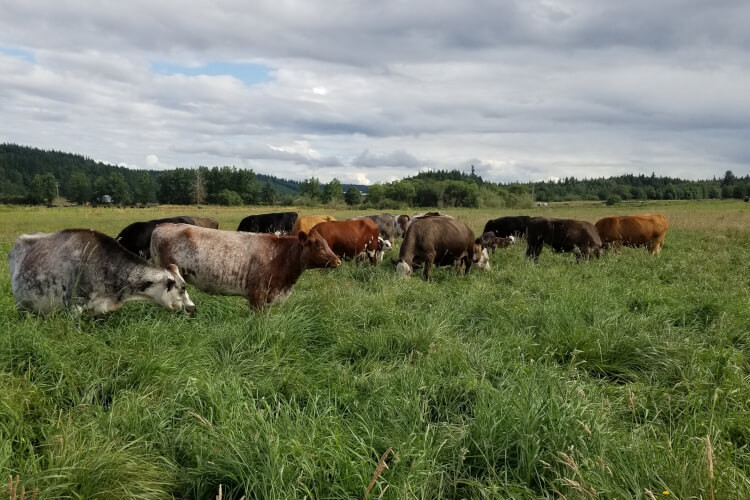Ham FAQ
posted on
April 12, 2022

We frequently receive questions about our ham, and rightly so. It is a different (and much better!) product than you typically find in the grocery store.
As a One Straw Ranch product, you know it is wonderful pasture-raised pork. That means a healthy and happy life for the pig, regenerative farming practices, and a delicious and nutritious product for your family.
But what do you do with it? And the packaging says some confusing things - what do they mean?
So if you find yourself with questions about the ham, perhaps one of our bullet points below will provide a helpful response.
As always, feel free to reach out to us if you have further questions.
Q: Why does the package say the ham is "uncured"? Does this mean it doesn't taste like ham?
The label on the ham says "Natural Uncured Ham". This is confusing. That wording makes it sound like it's just a fresh leg roast. Perhaps you need to season or brine it yourself? No, this is a ready-to-cook ham. It is pre-seasoned. Cook it as-is and enjoy the scrumptious taste of ham.
So why does it say "Uncured"? This confusion is the result of a food labeling regulation. Only foods containing synthetic nitrates are allowed to be labeled as "Cured" and our ham (and bacon, likewise) does not contain synthetic nitrates.
Q: How do I cook the ham?
This ham must be fully cooked. It is not like a partially cooked or pre-cooked ham from the grocery store that only needs to be reheated. In general, you want to cook this ham fairly low and slow until it reaches an internal temperature of about 160 degrees. This will give you a tender, sliceable roast.
At 350 degrees, this takes approximately 30 minutes per pound. If you have the time, cooking as low as 250 degrees will give even more time for the fat to render deliciously through the meat. I like to make sure the ham will not dry out, so I cook it covered with a bit of water and then remove the cover and turn up the heat for the last few minutes. This keeps the meat moist and then browns up the outside for a beautiful finish. You can add a glaze or not, as you prefer.
For a simple recipe, click here.
Q: Does the ham contain synthetic nitrates?
No. The ham does not contain any synthetic nitrates. It does contain sea salt and celery powder which naturally contain nitrates (other foods which naturally contain nitrates include leafy greens, beets, onions and garlic.)
Q: Is the ham pre-cooked?
No. This ham is not cooked at all and you must cook it to a safe internal temperature of at least 145 degrees F, though we suggest cooking the ham to 160 degrees.
Q: How do I thaw the ham? Can I thaw it quickly?
The ham can be thawed safely in the refrigerator over the course of several days, depending on the size of the ham and the temperature of your refrigerator. If you don't have time to wait for it to thaw in the refrigerator, you may safely thaw it in a basin of cold water. Place the ham, still in the package, in a large kettle, basin, or sink of cold water. Change the water every hour or so and the ham should thaw at about 1 hour per pound - so a three pound ham should take about 3 hours to thaw with occasional water changes. This is not an exact science, so plan as much extra time as possible. A hybrid method is to jumpstart the thawing process in cold water and then letting it finish overnight in the refrigerator or vice versa. Just make sure it stays below 40 degrees for food safety.
Q: Is the ham smoked? Why does it have smoke concentrate in it?
No, this is not a smoked ham. Due to regulations there is not a USDA-approved smoke shop in Washington State that is available to small producers, and in order to sell meat by-the-package (rather than a whole or half animal) it must be USDA-approved. I have spoken with our USDA butcher shop and they want to provide a smoked product but to date have not been successful in negotiating a solution with the USDA inspector.
Without the ability to smoke hams, the alternative is to use natural smoke concentrate in the brine. This is used in both the ham and the bacon, and it results in a delicious product.
Smoke Concentrate is actually smoke from a real wood fire that has been captured and distilled in water.
Q: What if my ham isn't the same color all the way through?
This is a small-batch, handmade, artisan product, which naturally results in variation. Sometimes the brine does not quite make it through the entire roast so what you are seeing is a small spot of less-brined pork.
This is purely aesthetic and does not affect the quality of the ham. Your roast will still be delicious.
Q: What ingredients are in the ham?
One Straw Ranch pasture-raised pork, water, sea salt, paprika, turbinado sugar, celery powder, natural smoke concentrate*, spices.
*Smoke Concentrate is actually smoke from a real wood fire that has been captured and distilled in water.





